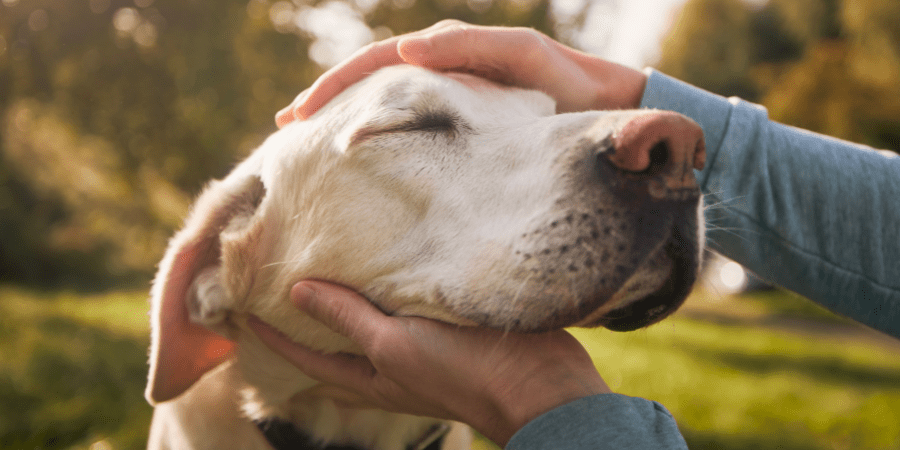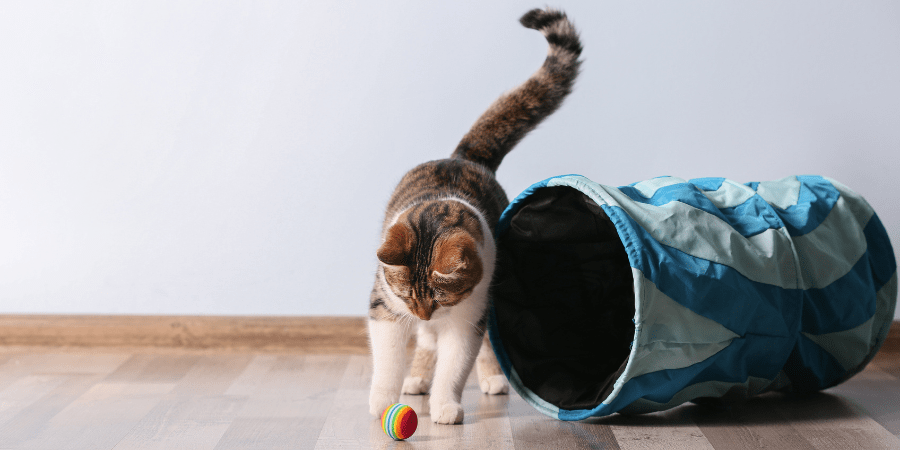Our Weigh Up campaign helps cat and dog owners learn about pet nutrition and exercise. Because together, we can ensure our four-legged friends live their best lives for longer – including our senior pets in their golden years!
Read on to discover how feeding your senior cat or dog an age-appropriate diet can support their needs.
At what age is a pet considered ‘senior’?
- Dogs, on average, are considered senior at about seven years old. However, this can vary based on breed, size, and overall health.
- Cats usually live longer than dogs, so they enter their senior stage of life a little later – from eleven years old.
Senior pets and weight changes
Pet obesity
Unfortunately, pet obesity is a common health problem for cats and dogs of all ages. In fact, our PDSA Animal Wellbeing (PAW) Report found that veterinary professionals estimate that 46% of dogs and 43% of cats are overweight or obese.
As they start to enjoy a slower pace of life, it’s no surprise that weight gain can be an issue for older pets. They may appear to have less energy and enthusiasm for getting up and moving, which can make it easier to pile on the pounds. And, as weight gain creeps on slowly over time, it can be less noticeable for owners.
If your pet has trouble burning off the calories they eat, it can lead to obesity, which can shorten their expected life span and affect their quality of life. Overweight pets are more at risk of developing certain health conditions (e.g. breathing problems and some cancers) and the extra pounds can put additional strain on the heart, other internal organs, and joints.
To keep your senior pet comfortable and at lower risk of weight-related issues, help them maintain a healthy weight. Feed them a good quality diet that suits their life stage and monitor their body shape (Body Condition Score) regularly. Making it part of your weekly routine will help you spot any weight changes early.
What about weight loss?
Monitoring your pet’s weight and shape is vital – just as important as spotting weight gain is being able to identify if your older pet loses weight. For older cats especially, weight loss can be the first sign of underlying health problems. It’s important to speak to your vet if your pet loses weight rapidly or you notice they have had significant weight loss and appear underweight, without a change in diet.
But remember, ‘slowing down’ and weight changes don’t have to be an inevitable part of ageing, and not all senior pets age the same way. If you see any changes in your older companion, talk to your vet as there are many treatments available to support pets through their senior years.

Read more:
How to battle the bulge and stop pet obesity
As a responsible owner, it’s important to work with your vet to monitor your pet’s weight and keep them in shape. They can advise you further on feeding the right diet and how to work through any exercise challenges.

1. Providing daily exercise to suit your pet
Your pet should stay active as they age because regular exercise will help maintain their muscle tone and promote healthy joints. Whether it’s enjoying playtime with your cat or taking a casual stroll with your dog, regular, daily movement is important. Taking shorter, manageable walks more often or having playtime during the day will help prevent weight gain and keep them mentally stimulated.
If you’re a dog owner, read our expert tips on exercising your senior dog.
2. Feeding your pet the right diet in the right quantities
Ensure your pet’s diet supports healthy ageing. Like us, senior pets need to eat a diet that supports their ageing bodies and meets their individual needs.
Feeding your pet the right amount of good quality food for their age can maintain good health, prevent age-related weight gain, and allow them to live a happy, healthy life. To achieve this, you may need to cut out extra treats or swap to a more suitable food for your pet.
How can old age affect a pet’s health?
In addition to weight gain, some age-related problems your senior pet may face include:
-
Stiff joints and reduced mobility
As pets get older, their joints may feel stiff and cause them discomfort.
Carrying extra weight will make things worse, especially if your pet already has arthritis or other joint problems. Overweight pets in particular may struggle to get up and move around. Sadly, this can lower their quality of life, especially when daily activities (such as going outside to the toilet) start to feel like an impossible task.
You can support your pet’s joints by providing:
- Soft but well-supported beds. Keep them slightly elevated from the floor and away from draughty doorways. Cats prefer to have their beds higher up, so add easily accessible steps.
- Ramps. Position them near doorsteps so your pet can get in and out of doorways with ease and use them to help your pet get into a car.
- Cat litter trays that have lower sides. If you live in a multi-storied home, make sure you have litter trays on each floor.
- Nonslip mats so your pet can more easily walk around on smooth floors.
Read more: Arthritis in dogs and cats
-
Uncomfortable lumps and bumps
Senior pets are more likely to develop fatty lumps (lipomas) and warts. Though lipomas are usually harmless and pain-free, they can sometimes grow very large and worry pet owners.
Both warts and lipomas can grow in awkward places and cause discomfort, especially when large. They can get in the way of movement or irritate your pet and can lead to them needing to lie in different positions. This can result in pressure sores and put your pet at risk of an infection.
Obesity raises the risk of our pets getting these lumps, so keeping their weight under control can help prevent them or slow their growth. If your pet already has a lipoma, weight loss may even reduce its size.
Some lumps will need to be removed with surgery. Always speak to your vet if you discover a lump on your pet, as there are many possible causes.
Read more: Tumours and lumps
-
Poor coat condition and loss of fur
As your pet ages, you may spot some obvious changes to their appearance, such as greying fur, particularly near the mouth and eyes. This is completely normal, but other changes to coat condition could suggest a health problem and shouldn’t be ignored.
A thin, clumpy, dull, or greasy coat may mean your pet is missing important nutrients in their diet or suffering from an underlying health condition. Always discuss these changes with your vet.
-
Dental disease
As your pet gets older, the wear and tear to their teeth can take its toll. Although regular brushing can keep your pet’s teeth in good condition, dental problems – such as missing teeth, gum disease, and tooth decay – are all common in senior pets.
Speak to your vet if you notice bad breath, bleeding gums, dropping of food when eating, or an unwillingness to chew.
Feeding the right diet for senior pets
Healthy ageing starts with a good diet. So once your pet hits the senior years, it’s a good time to review what they eat.
The ideal time to move on to senior pet food is when your pet reaches the senior age range. But even if they’ve been a senior for a while, it’s never too late to switch.
What makes senior pet food different to what we feed young or adult pets?
The goal of senior food is to provide older pets with high-quality, easy-to-digest ingredients. This allows their bodies to use the nutrients from their food more easily.
Senior pet food often contains:
- High-quality protein: older digestive systems can find the breakdown of some proteins more difficult. Protein is needed to help maintain muscle mass and support joints.
- Fewer calories: older pets can be less active, meaning they don’t need as much energy from their food as their younger counterparts. With fewer calories, senior pet food helps to manage your pet’s weight while providing all the vital nutrients.
- More fibre to help your pet’s digestive system and aid the passing of stools.
- Joint support nutrients to support your pet’s mobility.
- Antioxidants to support their immune system.
- Fatty acids to support skin and coat condition.

Consider your senior pet’s teeth
As an older pet’s appetite can be affected by dental issues, the shape, size, and hardness of kibble are carefully designed to suit them. But if they’re sore whilst awaiting dental care or recovering from dental treatment, you may want to move away from kibble for a while.
Switching to soft-textured foods with a lot of moisture (e.g. wet canned food or jelly pouches) will allow your cat or dog to eat comfortably even with missing teeth or sensitive gums.
Take it steady when making changes to a pet’s diet
Any changes to your pet’s diet should be done slowly, as sudden swaps can cause unpleasant digestive issues. If you’re planning to introduce senior pet food, add small amounts of the new food to your pet’s current food. Gradually add the new food and reduce their previous one over 7-10 days until you completely switch to the new food.
Remember, pets can’t feed themselves, so it’s up to you as their owner to feed them an age-appropriate diet. All senior pets have different needs, so if you’re unsure, speak to your vet as they’ll be able to give you advice based on your pet’s age, health, and lifestyle.
For more expert guidance on pet nutrition and exercise, visit our Weigh Up page.
